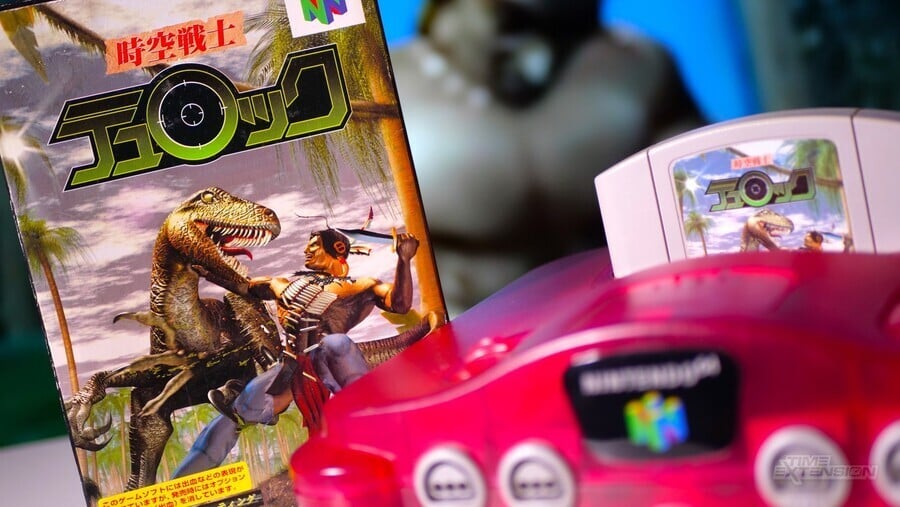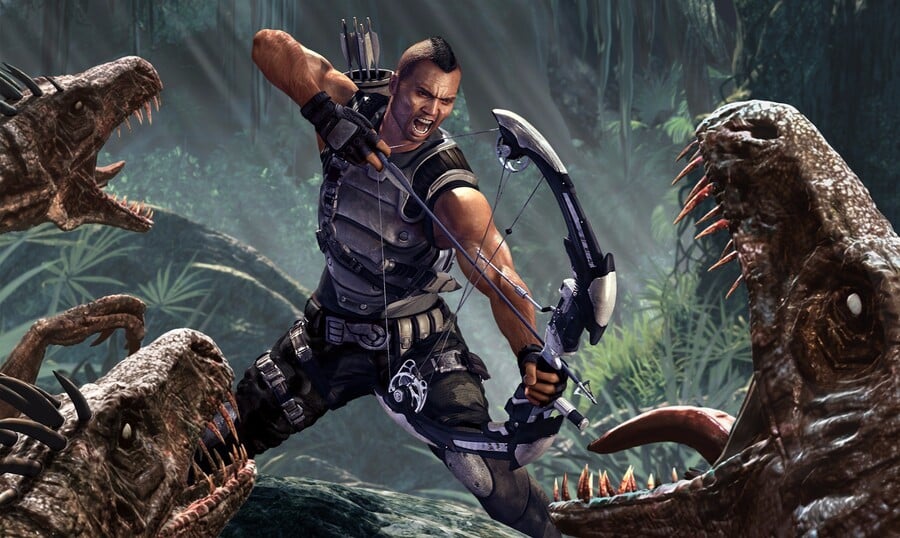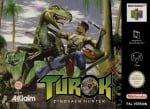
When it comes to the Nintendo 64 and first-person shooters, there are two titles that have become synonymous with the genre: GoldenEye 007 and Perfect Dark. While these classics rightfully deserve their place among the greats, the Turok series has largely fallen into obscurity, which is a crying shame when you consider that Turok: Dinosaur Hunter blazed a trail which Rare's games would duly follow; it was a first-person shooter built for the console market that brought the genre forward with its own blend of open level design and prehistoric ultra-violence.
Developed by Iguana Entertainment and released in March 1997, Turok: Dinosaur Hunter was an unusual game for its time. Not only was it a satisfyingly bloodthirsty offering for a Nintendo platform, but before its release, FPS games were largely confined to home computers. Although Turok came out after the first wave of games for the N64 in Japan and North America, it arrived only a few days after the console's March 1997 launch in Europe and Australia, meaning players in those regions were greeted with the sight of a Native American kicking major reptilian arse alongside Nintendo's portly plumber in Super Mario 64. For this reason, many PAL gamers associate the game quite strongly with the N64, as it was one of the first titles they played on the platform.
Turok's tale of creation is anything but straightforward. The game's origin begins as a licensed property which stretches back to the 1950s comic book Turok: Sun of Stone. It originally focused on Mandan Native Americans Turok and his brother Andar as they found themselves trapped in a valley filled with dinosaurs. The series was later revamped by Valiant Comics in 1992, eventually turning into Turok: Dinosaur Hunter - where the ideas of the Lost Land, aliens and "binosaurs" entered the mix. It was this version of the comic that would turn into the video game we know today.
Creative director Nigel Cook fills us in on how the transition took place. "Acclaim Entertainment had recently purchased Iguana Entertainment," he says. "After relocating from Silicon Valley to Austin, Texas, we heard that Acclaim had bought a small Manhattan-based comic book company called Valiant Comics, so a box of comics arrived at our office for review. Immediately, the Turok comic stood out as the main contender to develop on the Nintendo 64." And it seems warm relations between Nintendo and Iguana/Acclaim also aided the process. "We chose the N64 due to our already great relationship with Nintendo, and after we completed the NBA Jam port, Nintendo was interested in having us develop an exclusive title for them."
We heard that Acclaim had bought a small Manhattan-based comic book company called Valiant Comics, so a box of comics arrived at our office for review
In order to make the comic book come to life, an 18-strong development team was assembled, led by industry newcomer David Dienstbier. But even in the early stages of development, player perspective was up for debate, as Cook explains. "We did consider a third person or over-the-shoulder view, but we felt first-person would be ideal to engage the player in the experience of hunting prey or being hunted."
One way this was translated to the player was through innovative level design. The game's eight stages featured a more open approach reflecting Turok's surroundings, with multiple routes to explore and a key-collection system to open up further stages. "Turok's more natural level design was more appropriate for his locales," says Cook, detailing the organic approach to level design further. "We wanted the game to feel larger than it is by incorporating an organic gameplay path. Many FPSs back then used what we called the 'cathedral' design: one long hallway connected to a big room, then another hall to another big room."
But to wholly capture the spirit of the hunt, Turok needed an assortment of intimidating enemies, and it didn't disappoint. While the early levels of the game featured humans and dinosaurs such as velociraptors, later stages included undefinable alien creatures and gargantuan bosses - the most notable being a giant mantis and a bionic T-Rex equipped with fire breath and eye lasers. "The team's producer, David Dienstbier, mainly came up with characters," explains character animator and 3D modeller Greg Omelchuck. "But we did have freedom on animations and the look of things, which was very fun for an artist."
We had to animate the body first and then manually move the legs frame by frame... we had to improvise and problem-solve to create the animations
Seeing these enemies in glorious 3D was a real treat for '90s gamers, as many previous first-person shooters contained characters and settings made of 2D sprites. And it was thanks to new steps forward in 3D animation that allowed them to gain a sense of realistic movement and behaviour, as Omelchuck explains. "For the humans, all the animation was motion captured. For the dinosaurs, it was all animated in 3D Studio Max v4. This was before inverse kinematics, so we had to animate the body first and then manually move the legs frame by frame. This was the beginning of the 3D animation era, and all the tools were not in the packages, so we had to improvise and problem-solve to create the animations." Omelchuck sums up the approach in a more colloquial fashion. "We were flying by the seat of our pants halfway through the project!"
These visual aspects were impressive for the N64 at the time, made possible due to the custom tools and technology created by the dev team. However, for the first half of development, the N64's hardware had not even been finalised. "As we built our tools and tech, as well as our game editor, we were fearful of potential hardware changes along the way," Cook tells us. But thanks to the Big N, this part of the process managed to go relatively smoothly. "Thankfully, Nintendo did a wonderful job at keeping us informed about any changes that may have affected development. Halfway through, we received the final development kits, which led to very little rework."
However, one cannot examine a first-person shooter without discussing weaponry. And Turok was among the more creative, providing much pain-inflicting fun with a ridiculously destructive arsenal. Starting off with bows and light firearms, later weaponry included imaginative tools of destruction such as the Fusion Cannon - a large glowing contraption which could cause a nuclear explosion. "David Dienstbier had the vision to incorporate over-the-top weapons," Cook explains. "We knew we were not developing a simulation, and that the Turok universe is not like ours, so why not go over the top with weapons and have fun unleashing them? David made sure the weapons ramped up as enemy difficulty ramped up in the game. Weapons became more powerful and over-the-top as the game progressed, which became one of Turok's core features."
There were very few games with violent content at that time and we knew that it would be the number one point of contention for Nintendo
But with Nintendo's family-friendly image, many would be wise to assume that with explosions, impalements and blood spurts aplenty, Iguana would have trouble getting the Japanese giant to agree to such delicious displays of violence. "There were very few games with violent content at that time, and we knew that it would be the number one point of contention for Nintendo," explains Cook. "Luckily, at that time, Nintendo was interested in expanding their game styles and genres. And while Turok was positioned at the very edges of their violence threshold at that time, they still agreed to the game."
Alongside the potential issue of violence, were the technical sacrifices that had to be made. Most notably, the use of fogging so that the draw distance of objects coming into view would be shorter, while their appearance would feel gradual. It is an issue which has caused debate since release - some claim that it hinders the sense of being involved in the world of the game. Others argue that it enhances the feeling of venturing into the unknown, heightening tension when enemies appear. Omelchuck explains the technical reasons behind its inclusion. "This was early 3D, and the N64 hadn't been put to the test, so pushing 3D and texture maps was new. Rob Cohen and the engineering team had to create a fog system in order to draw the characters and the environment. We were already pushing extremely low poly characters and small 32x32 pixel maps. The fog was the only thing at the time to get the frames-per-second up and create the game we wanted."

But it wasn't the only aspect of the game that some cast doubts about. A part of the exploration also involved platforming sections, some of which became a bit ridiculous in later levels. But as Omelchuck explains, it was the release of Super Mario 64 later on in development that inspired their inclusion. "David Dienstbier and Alan Johnson [Lead Artist] loved the platforming aspect of it. So as feature creep goes, so did the platforming aspect into Turok." But it appears it wasn't only critics and fans who were divided on this aspect of the game, as Omelchuck continues. "Near the end of the project, as the levels were coming together, it became silly where it was just a hopping experience. The team was divided on whether it worked or not. I still thought it was too much hopping."
The writing was on the wall that Turok was going to be a hit so, smartly, Iguana offered everyone on the team bonuses at the end of the project
Hopping and fogging issues aside, Turok: Dinosaur Hunter was released to rave reviews and became a huge commercial success. But, due to early demos being a huge hit at trade shows (with even Acclaim's top brass having played them), success was largely expected. "The writing was on the wall that Turok was going to be a hit so, smartly, Iguana offered everyone on the team bonuses at the end of the project. That seemed to keep all of us going!" Omelchuck fondly recalls. When asked about his favourite part of Turok's development, Omelchuck explains the feeling of exploring uncharted territory. "My favourite memory was knowing that we were actually inventing the wheel, not re-inventing it. As a whole, the team knew that we were on the cutting edge, and so that was always exciting."
This success and innovation put Turok and Iguana on the map, leading to a PC port and an even better sequel on Nintendo's 64-bit wonder, as well as kick-starting an entire franchise that stretched into the last console generation with the titular 2008 game Turok. Even though Turok: Dinosaur Hunter has its share of issues, it is an undeniably fun title which revels in mayhem and reptilian destruction - even if the N64 control scheme is somewhat alien to today's world of dual analogue sticks.
But the story of the game doesn't finish there. In December 2015, a HD remaster by Night Dive Studios was released, combining the best aspects of both the N64 and PC originals. Looking back, it's incredible to consider that it was possible for a team of eighteen people to create such a high-profile release, and Cook offers an interesting perspective on the resurrection of old games and traditional development approaches. "The resurgence of old games is refreshing. It's interesting to see how they hold up compared to modern titles. There is something raw and engaging about old games, especially when they are not forced through the publisher models; instead, they are made by gamers for gamers. I hope the trend continues."
Huge thanks to Nigel Cook and Greg Omelchuck for their time.

